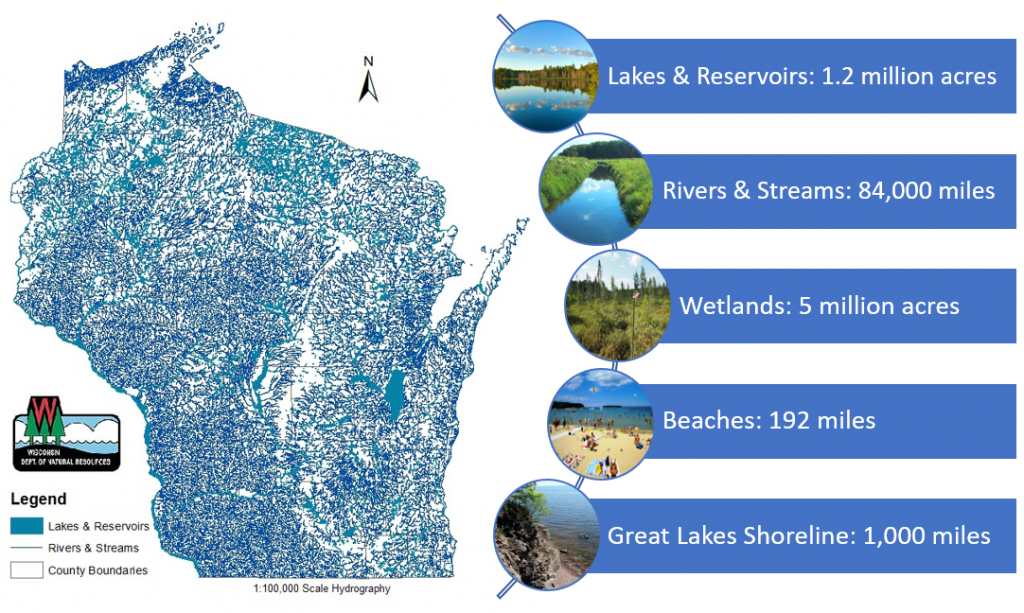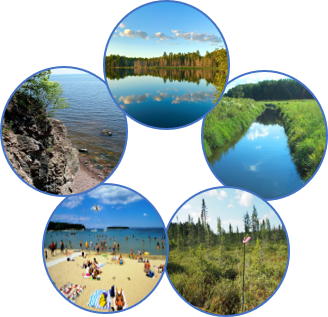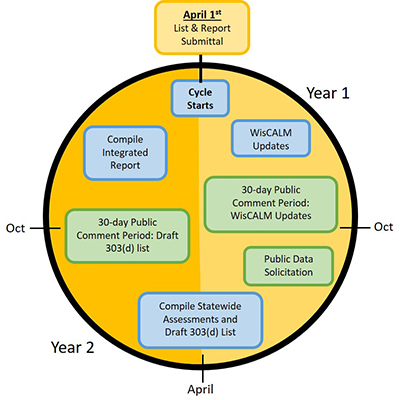Surface Water Quality Assessment Process
The Clean Water Act (CWA) requires states to assess the quality of its surface waters and report the results to the public.
Timeline
Surface water quality assessments occur in two-year cycles. The DNR submits an impaired waters list and surface water quality report to the EPA by April 1 of even-numbered years.
During the first year of the assessment cycle the listing methodology is updated, the public has a chance to comment on the updates and the public is asked to submit any water quality data they would like used in the assessments.
During the second year the assessments are done, the regional DNR biologists review the draft list, the public has the opportunity to comment on the draft list and DNR staff write a report on the state of the state's surface waters.
During the assessment process, the public is given three opportunities to participate.
Spatial Scale
Resource Maps
Wisconsin has more than 12,600 rivers and streams that meander their way through 84,000 miles of varying terrain. About 32,000 miles of these streams perennially run, or continuously throughout the year; the remainder flow intermittently during spring and other high water times.
Wisconsin has 15,000 lakes that cover about 1.2 million acres of the state. Breathtaking scenery and beautiful wildlife provide the backdrop along thousands of miles of shoreline, where Wisconsin residents and our visitors can fish, boat, swim or just relax and enjoy the peaceful atmosphere.

Assessment Process Overview
Surface water quality assessments follow a basic set of steps that help determine if water is meeting quality standards.

Step 1. Identify water type
Question asked: What type of surface water is this?
The type of water influences how it is assessed. In addition to a general distinction between lakes, reservoirs, rivers, streams and beaches, the DNR looks at other factors like depth, flow and aquatic communities present.
For more details, see Natural communities.
Step 2. Identify uses

Question asked: What is this water used for when healthy?
Each waterbody is expected to support specific uses, called designated uses,
which include:
- Aquatic Life (AL): Can aquatic organisms live and reproduce?
- Recreation (REC): Can people safely recreate (boat, swim, etc)?
- Public Health & Welfare (PHW): Can people safely eat the fish from this water?
- Wildlife (WL): Can wildlife safely use the waterbody for food or part of their life cycle?
For more details, see Designated uses.
Step 3. Identify water quality benchmarks
Question asked: What levels are protective?
Benchmarks, including numeric criteria, are found in administrative code and in Wisconsin's assessment and listing methodology.
Step 4. Compare monitoring data to benchmarks
Question asked: Is this water meeting its uses?
Monitoring data is stored in the SWIMS database and assessment programming has been written for several water quality parameters. These assessment packages compare the data to the criteria based on identified water type, uses and appropriate criteria. This information is used for water quality classification.
Step 5. Determine EPA 5-part categorization
Question asked: What list does this water belong on?
Depending on the assessment results the water will be placed in one of 5 categories, which correlate with three lists.
For more details, see Water condition lists.
Step 6. Finalize lists and report to Congress
Question asked: What is the status of Wisconsin's waters?
The lists are compiled and then reviewed by regional DNR biologists. The list is also given to the public for review. The lists and assessments are used to create the water quality report to Congress.
For more details, see Water quality reports to Congress.

